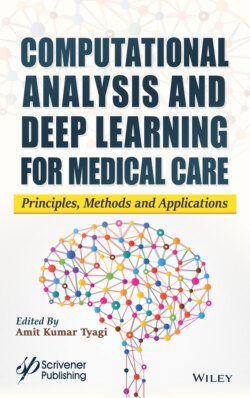Читать книгу Computational Analysis and Deep Learning for Medical Care - Группа авторов - Страница 10
Оглавление
Preface
Due to recent technological developments and the integration of millions of Internet of Things (IoT)-connected devices, a large volume of data is being generated every day. This data, known as big data, is summed up by the 7 V’s—Volume, Velocity, Variety, Variability, Veracity, Visualization, and Value. Efficient tools, models and algorithms are required to analyze this data in order to advance the development of applications in several sectors, including e-healthcare (i.e., for disease prediction) and satellites (i.e., for weather prediction) among others. In the case of data related to biomedical imaging, this analyzed data is very useful to doctors and their patients in making predictive and effective decisions when treating disease. The healthcare sector needs to rely on smart machines/devices to collect data; however, nowadays, these smart machines/devices are facing several critical issues, including security breaches, data leaks of private information, loss of trust, etc.
We are currently entering the era of smart world devices, where robots or machines are being used in most applications to solve real-world problems. These smart machines/devices reduce the burden on doctors, which in turn make their lives easier and the lives of their patients better, thereby increasing patient longevity, which is the ultimate goal of computer vision. Therefore, our goal in writing this book is to attempt to provide complete information on reliable deep learning models required for e-healthcare applications. Ways in which deep learning can enhance healthcare images or text data for making useful decisions will be discussed. Also presented are reliable deep learning models, such as neural networks, convolutional neural networks, backpropagation, and recurrent neural networks, which are increasingly being used in medical image processing, including for colorization of black and white X-ray images, automatic machine translation images, object classification in photographs/images (CT scans), character or useful generation (ECG), image caption generation, etc. Hence, reliable deep learning methods for the perception or production of better results are a necessity for highly effective e-healthcare applications. Currently, the most difficult data-related problem that needs to be solved concerns the rapid increase of data occurring each day via billions of smart devices. To address the growing amount of data in healthcare applications, challenges such as not having standard tools, efficient algorithms, and a sufficient number of skilled data scientists need to be faced. Hence, there is growing interest in investigating deep learning models and their use in e-healthcare applications.
Based on the above facts, some reliable deep learning and deep neural network models for healthcare applications are contained in this book on computational analysis and deep learning for medical care. These chapters are contributed by reputed authors; the importance of deep learning models is discussed along with the issues and challenges facing available current deep learning models. Also included are innovative deep learning algorithms/models for treating disease in the Medicare population. Finally, several research gaps are revealed in deep learning models for healthcare applications that will provide opportunities for several research communities.
In conclusion, we want to thank our God, family members, teachers, friends and last but not least, all our authors from the bottom of our hearts (including publisher) for helping us complete this book before the deadline. Really, kudos to all.
Amit Kumar Tyagi
